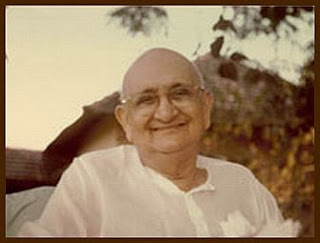"Saints are beacons. Saints show the path. They hearten you in your struggle. Their words should carry absolute weight with you. They can awaken and enthuse you. But you have to advance on the path by your own growing inner power and will. You should feel conscious that the divine within is your sole refuge." [Swami Ramdas]
Swami Ramdas is another prominent saint of the 20th Century who is connected with Arunachala and spent a short time on the Hill living in a cave and performing austerities.

He was born in 1884 at Hosdrug, Kerala, India, and named Vittal Rao. He lived an ordinary life as householder in his community until he was thirty-six years of age, at which time an intense spritual transformation occured in him which filled him with an overwhelming wave of dispassion
At that critical time, his father initiated him into Ram mantra and assured him that by repeating it unstintingly he would, in due time, find true peace and happiness. As the mantra took hold of him, he found his life filled with Ram. It was then that he renounced wordly life and went forth in quest of God.
Eventually his travels took him to Tiruvannamalai, where he met with Sri Ramana Maharshi, Ramdas later said of the meeting, “The Maharshi, turning his beautiful eyes towards Ramdas, and looking intently for a few minutes into his eyes as though he was pouring into Ramdas his blessings through those orbs, nodded his head to say he had blessed. A thrill of inexpressible joy coursed through the frame of Ramdas, his whole body quivering like a leaf in the breeze.”
In that ecstatic state he left Maharshi's presence and went to spend nearly a month in a cave on the slopes of Arunachala to engage in the constant chanting of Ram mantra. This was the first occasion that he went into solitude. After twenty-one days, when he came out of the cave he saw a strange, all-pervasive light: everything was Ram and only Ram.
Following his experience in the caves of Arunachala, Ramdas continued his travels for nearly eight years which took him to many parts of India. Finally he settled down in Kanhangad, Kerala where the present Anandashram was founded in the year 1931.

One of the foremost amongst followers of Swami Ramdas was the great Indian sage Yogi Sri Ramsuratkumar (photograph above), who in 1952, achieved self realisation under the grace and light of his Swami. Yogi Ramsuratkumar attained samadhi at his own Ashram at Tiruvannamalai on February 20, 2001.


































